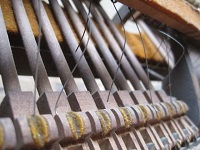
Hammer butt (or hammer rail) springs perform an essential function in the action of the vertical piano. Each time a note is played, the hammer must swiftly return to rest position. The hammer butt spring is responsible for this task. Although these springs are simple in design and typically need no maintenance over the life of a piano, they can be easily bent or knocked out of position. In some cases, the spring metal becomes brittle and breakage occurs. When this happens, broken springs may either be replaced individually or as a set. If the hammer butt springs on your piano are showing signs of brittleness then either spot replacement or the replacement of the entire set should be considered.
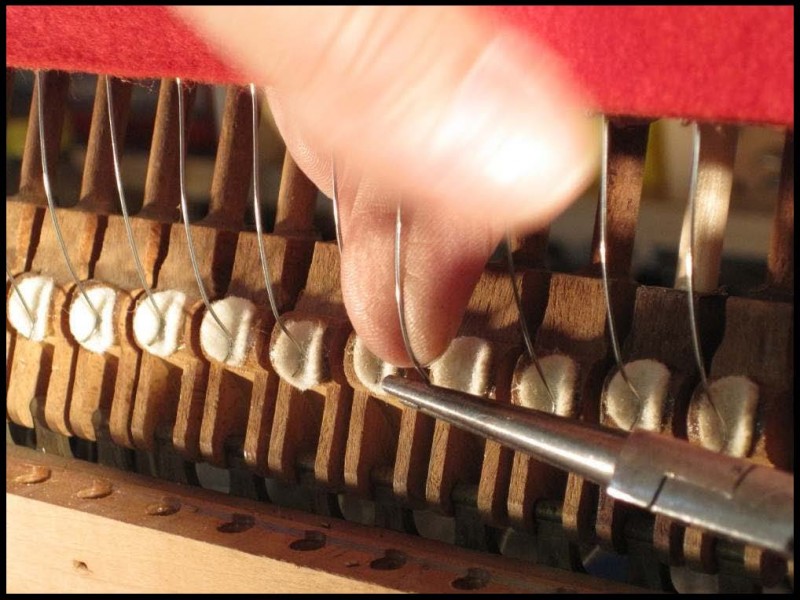 A new set of originaltype springs being given final adjustments in the action.
A new set of originaltype springs being given final adjustments in the action.
With hammer butt springs being so simple in design, what goes wrong with them that they bend or become knocked out of position or broken?
Many times the simple act of retrieving an item which has fallen inside the action of the piano, such as a pencil or paper clip, causes the springs to be bumped out of position. Other times a spring will slip out of position on its own during hard play. When the effort is made to reposition a spring it is very easy to bend the spring the wrong way or put a kink in the spring metal. Also, loose springs will sometimes jam up against the hammer butt and will become bent in that way.
Once a spring has a sharp bend in it, it is more likely to break. Especially as a piano ages, springs in the piano action are prone to metal fatigue, increasing the chance of broken springs.
For fixing the occasional broken hammer butt spring, is there an onthespot solution available?
Yes. For an onthespot replacement, a hammer butt repair spring may be used to replace a broken spring. The repair spring has a brass clip that may be screwed onto the hammer spring rail, as shown in the photo below.
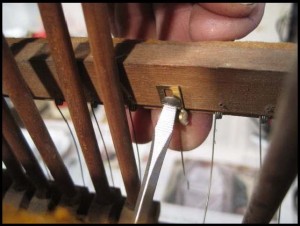 Although supply catalogues claim this is an easy repair (“Quickly installed in any upright action without removing the spring rail. . .”), it can be a very aggravating job when the small part has to be installed amidst all the other parts. (In the photo, adjacent hammer assemblies and the hammer rest rail have been removed for clarity.)
Although supply catalogues claim this is an easy repair (“Quickly installed in any upright action without removing the spring rail. . .”), it can be a very aggravating job when the small part has to be installed amidst all the other parts. (In the photo, adjacent hammer assemblies and the hammer rest rail have been removed for clarity.)
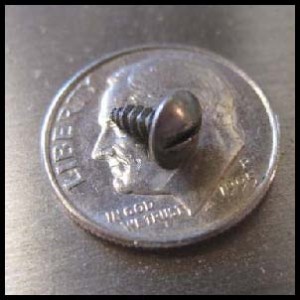 The screw supplied for the repair clip is tiny, and even when using a special screwholder, it can be a challenge to get started. Especially when trying to hold the clip in place with one hand, maneuvering the screw around the hammer rest rail and hammer shanks without the screw popping off the screw holder can be an exercise in frustration.
The screw supplied for the repair clip is tiny, and even when using a special screwholder, it can be a challenge to get started. Especially when trying to hold the clip in place with one hand, maneuvering the screw around the hammer rest rail and hammer shanks without the screw popping off the screw holder can be an exercise in frustration.
For a vintage instrument that is being restored, is the use of repair springs the best method available?
Repair springs are an acceptable and affordable option which is most appropriate when a limited number of springs are being replaced. For a quality restoration, however, the use of originaltype hammer butt springs (as shown on the next several pages) would be a better choice. By doing so the new springs would most closely match the piano’s original specifications. Also, by replacing the entire set of springs instead of just those actually broken, future problems caused by brittle spring metal would be eliminated.
Is the replacement of a set of hammer butt springs with an original type set of springs a complicated repair, or is simple enough that it may be conveniently done in the customer’s home?
With the amount of time involved in the repair, it would probably be best to do this repair in the workshop. One advantage would be that while in the shop, other issues with the action of the piano could also be addressed.
Hammer butt springs are obviously simple in operation . What makes their installation complicated?
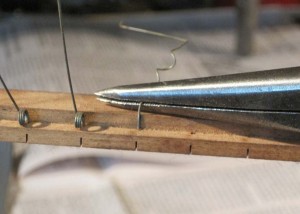 There’s a step-by-step process which must be followed. There is no quick and easy way to do the job correctly. First of all, the hammer butt spring rail is removed from the action. The old springs are then carefully removed by pulling each spring wire free.
There’s a step-by-step process which must be followed. There is no quick and easy way to do the job correctly. First of all, the hammer butt spring rail is removed from the action. The old springs are then carefully removed by pulling each spring wire free.
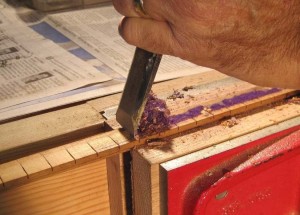 The spring rail felt on the back of the rail is scraped off and will be replaced at a later stage in the process.
The spring rail felt on the back of the rail is scraped off and will be replaced at a later stage in the process.
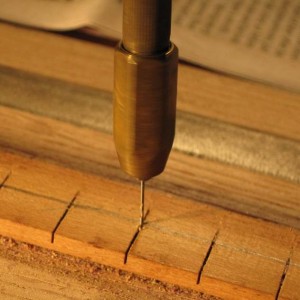 A .025″ hole is next drilled in the hammer butt spring rail for the tail of each spring to be inserted through. (The insert shows the size of this drill bit in comparison to a penny, and an ordinary 1/16″ bit.)
A .025″ hole is next drilled in the hammer butt spring rail for the tail of each spring to be inserted through. (The insert shows the size of this drill bit in comparison to a penny, and an ordinary 1/16″ bit.)
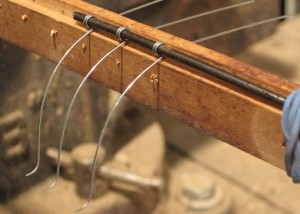 The tail of each new spring is then inserted though the original hole in the rail. (The short sliding wire helps keep the coils of the springs in line while the process is being completed.)
The tail of each new spring is then inserted though the original hole in the rail. (The short sliding wire helps keep the coils of the springs in line while the process is being completed.)
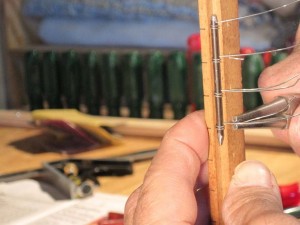 The long tail of each spring is then pulled through the tiny hole which has been drilled. (This step allows the spring metal to be drawn tightly into the slot on the opposite side of the spring rail which the original spring was inserted into at the factory.)
The long tail of each spring is then pulled through the tiny hole which has been drilled. (This step allows the spring metal to be drawn tightly into the slot on the opposite side of the spring rail which the original spring was inserted into at the factory.)
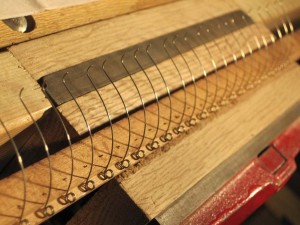 The springs are given fine adjustments while the set is held in place in the vise so that each of the springs lines up perfectly with its neighboring springs. Adjustments from sidetoside, and up and down are required to even out the line.
The springs are given fine adjustments while the set is held in place in the vise so that each of the springs lines up perfectly with its neighboring springs. Adjustments from sidetoside, and up and down are required to even out the line.
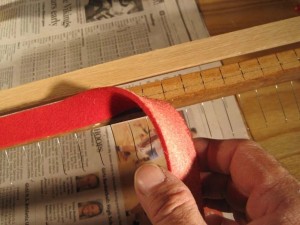 A new length of fresh spring rail felt is now glued to the back of the hammer spring rail. It is essential that this felt be of the correct width and thickness. This felt is clamped in place in a press overnight to ensure adhesion.
A new length of fresh spring rail felt is now glued to the back of the hammer spring rail. It is essential that this felt be of the correct width and thickness. This felt is clamped in place in a press overnight to ensure adhesion.
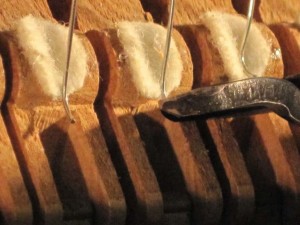 When the new set of hammer springs are reinstalled into the action of the piano, final adjustments are often necessary. Here, springs which are just a bit too long are clipped to the correct length, after which a new curved end is formed.
When the new set of hammer springs are reinstalled into the action of the piano, final adjustments are often necessary. Here, springs which are just a bit too long are clipped to the correct length, after which a new curved end is formed.
Are there other repair jobs which should be done in conjunction with this particular repair?
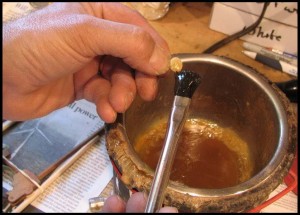 Yes, if the action were in fact worked on in the shop, it would be the ideal time to make any other necessary repairs.
Yes, if the action were in fact worked on in the shop, it would be the ideal time to make any other necessary repairs.
In particular, with a new set of hammer rail springs, it would be highly appropriate to install new felt punchings to line the hammer butt groove that the springs fit into. In the photo, hot hide glue is applied to the back of a felt punching prior to installation.
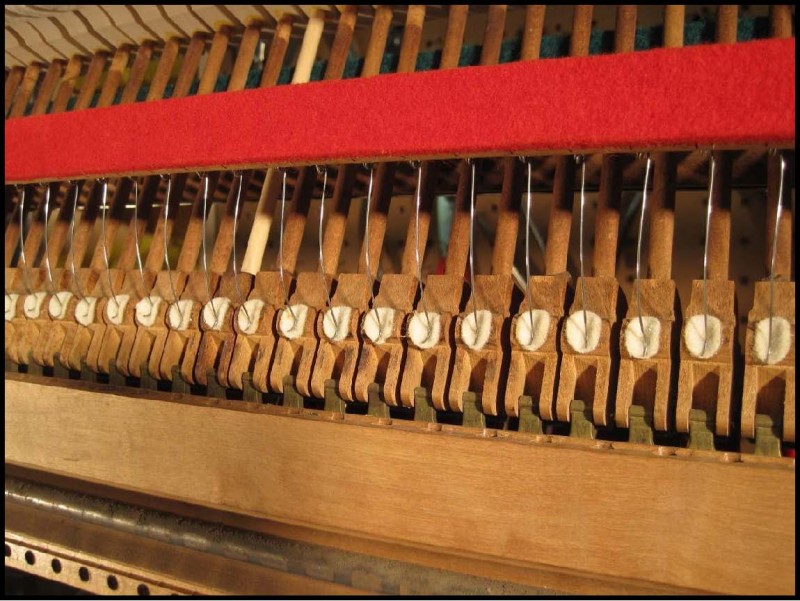 A net set of hammer rail springs helps complete an upright action restoration job.
A net set of hammer rail springs helps complete an upright action restoration job.